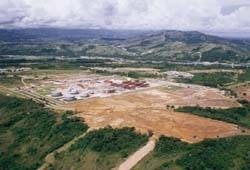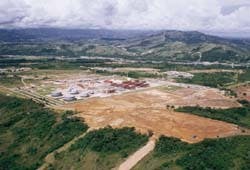COLOMBIA PINS HOPE FOR OIL EXPORT HIKE ON BP GROUP'S CUSIANA-CUPIAGUA PROJECT
A.D. Koen
Senior Editor-News
While the country's public finance sector remains essentially in balance, Colombian leaders say reforms are needed to create a more equitable tax system and reverse a growing budget deficit.
Toward that end, officials on the one hand are abolishing certain tax privileges while removing or lowering some fees levied on key areas of investment. They aim to fund the economic liberalization with revenue earned on world oil markets.
Most of the increased oil export volumes are to come from Llanos foothills fields on the eastern slope of Colombia's eastern Andean mountain range. Officials estimate combined probable and possible oil and gas reserves at 6 billion bbl of oil equivalent (BOE). Foremost among the fields is the Cusiana- Cupiagua complex in Casanare province, about 150 km northeast of Bogota, with an estimated 2 billion bbl of oil.
PHASED DEVELOPMENT
Operator BP Exploration Co. (Colombia) Ltd. and partners have wrapped up Phase I development in the Cusiana-Cupiagua project. That ramped up Cusiana production to 185,000 b/d from lower Eocene Mirador, Paleocene Barco, and upper Cretaceous Guadalupe pays below 15,000 ft.
Cusiana producers flow an average 12,000 b/d/well. One of the wells, 11 Buenos Aires, is producing 37,000 b/d, believed to be the biggest flow from a single well in South America.
Colombia's state owned Empresa Colombiana de Petroleos (Ecopetrol) holds 50% interests in association contracts covering the Cusiana-Cupiagua complex. BP and Total Exploratie en Produktie hold 19% each, and Triton Colombia Inc. 12%. The fields occupy parts of the Santiago de las Atalayas, Tauramena, and Rio Chitamena association contract areas.
Partners in Phase I achieved commercial production in 15 months about $100 million under budget.
Meantime, work has begun on Phase II development, in which combined Cusiana-Cupiagua production is to reach more than 500,000 b/d by yearend 1997.
BP in addition is laying plans for a third phase of Llanos foothills oil and gas development that could lift regional oil production to more than 650,000 b/d early in the next century. The company in Phase III envisions developing the Volcanera, Florena, and Pauto Sur discoveries at a combined cost of $3-4 billion. BP estimates combined reserves of the fields at 1 billion BOE and 10 tcf of gas.
Cusiana-Cupiagua Full Development Budget* table (41026 bytes)
PHASE II
BP and partners in Phase II are to extend development to Cupiagua field and expand early production system (EPS) facilities installed since October 1993 for commercial production of Cusiana field.
EPS components include:
- 14 production wells in Cusiana field, five gas injection wells, and two water disposal wells.
- The Cusiana central processing facility (CPF), which consists of four processing trains and storage for about 300,000 bbl of crude.
- 35 km of 20 in. oil pipeline from Cusiana to a tank farm and pump station at El Porvenir, 96 km of 30 in. line between La Belleza and Vasconia, and pump horsepower additions.
- Export facilities at Covenas on Colombia's Caribbean coast, including six 350,000 bbl storage tanks - four of them already in use - a 2 million bbl floating storage unit (FSU), and a 30,000 bbl/hr tanker loading unit (TLU).
Oil begins the 800 km trip to Colombia's Caribbean coast at the Cusiana CPF, where gas and water are separated from the oil stream and reinjected, the former to maintain reservoir pressure. Output from each of the four EPS trains in the Cusiana CPF amounts to 40,000-45,000 b/d of oil and 80 MMcfd of gas.
Processed crude flows from the CPF to El Porvenir, where it is stored separately from crude produced from other fields in the region.
Cargos of Cusiana crude flow north from El Porvenir on the Central Llanos pipeline in shipments of about 500,000 bbl to Vasconia. There the oil enters the Oleoducto de Colombia (ODC) pipeline system for shipment to Convenas. Crude is relayed over the Andes mountains to Vasconia by pump stations at Miraflores and La Belleza.
PHASE II PREVIEW
BP and partners in Phase II officially are to begin developing Cupiagua field. But work related to Phase II already is under way in Cusiana and Cupiagua.
Partners estimate Cupiagua reserves at 500 million BOE.
Combined Phase I and Phase II drilling plans include completion in Cusiana of 55-60 production wells, 1520 gas injection wells, and six to 10 water disposal wells. At Cupiagua, partners could drill as many as 40 production wells, six gas injection wells, and three water disposal wells.
Partners in Phase II will construct a CPF at Rio Charte for Cupiagua production. The plant is to include two 100,000 b/d oil processing trains.
In Phase II at the Cusiana CPF, partners are to install two 80,000 b/d processing trains and expand storage capacity to 1 million bbl.
Along with Phase I components, Cusiana-Cupiagua facilities after Phase II will be able to process more than 500,000 b/d of crude. That capacity is to be matched by Phase II pipeline con- struction between El Porvenir and Covenas.
PIPELINES
Cusiana-Cupiagua partners in December 1994 joined with units of Canada's TransCanada and Inter-provincial pipeline companies to form Oleoducto Central SA (Ocensa). Ocensa is to oversee construction of Phase II transportation facilities and own and operate the combined Phase I and Phase II infrastructure.
Phase II pipeline construction plans include laying 35 km of 30 in. line from Cusiana's CPF to El Porvenir, 55 km of 30 in. from El Porvenir to Miraflores, and 130 km of 36 in. line from Miraflores to La Belleza. Those pipeline segments, dubbed collectively the southern route, will replace the 20 in. Central Llanos pipeline owned and operated by Ecopetrol between El Porvenir and La Belleza.
Phase II southern pipelines at La Belleza tie into the 30 in. pipeline laid in Phase I to Vasconia.
Ocensa also is to add about 260,000 bbl of storage for Cusiana-Cupiagua crude at El Porvenir, along with pump horsepower.
From Vasconia, Ocensa in Phase II is to lay the so-called northern route, consisting of 475 km of 30 in. oil pipeline to loop the existing 24 in. ODC line to Covenas.
Also in Phase II, Ocensa is to add three 350,000 bbl storage tanks at Covenas, boosting total storage capacity dedicated to Cusiana-Cupiagua crude at Covenas to more than 3.1 million bbl. (41026 bytes)
Also at Covenas, Ocensa in Phase II is to install a 60,000 bbl/hr TLU. Coupled with the Phase I TLU, tanker loading capacity after Phase II will reach 90,000 bbl/hr. Ecopetrol operates a third TLU at Covenas with a capacity, of 60,000 bbl/hr.
FULL DEVELOPMENT
Effects of full field development during Cusiana-Cupiagua Phase II will show up early in 1997, as Cusiana oil production begins climbing to 320,000 b/d. Cupiagua is to begin coming on line about mid-1997, with production advancing to about 200,000 b/d.
Cusiana-Cupiagua partners at the end of October let contracts for all major Phase II facilities.
Ocensa in late October had received about half of the pipe needed for Phase II construction. Construction of Phase II crude lines could begin as early as mid-November, with work to proceed on four fronts.
Effects of Cusiana-Cupiagua development on Colombia's oil exports will be dramatic. All of the fields' production has been earmarked for foreign markets, mainly in the U.S. Tankers leaving Covenas can land at U.S. oil terminals on the Gulf Coast in 5 days and at terminals on the East Coast in 6 days.
With Phase I and Phase II facilities in full operation, Ecopetrol officials estimate as many as twenty 500,000 bbl shipments of Cusiana-Cupiagua oil could be exported from Covenas. Colombian oil exports in 1994 averaged 270,000 b/d and by 2000 could exceed 600,000 b/d.
Colombia's strategy of selling all its Cusiana-Cupiagua crude in the U.S. appears solid long term. The U.S. Department of Energy has projected that net U.S. crude oil imports will increase to 11 million b/d by 2000. U.S. refiners in 1994 imported an average 8.9 million b/d, as domestic production declined to 6.6 million b/d.
However, U.S. producers in the past year have slowed the country's production decline. So it is less certain whether all of Colombia's incremental oil exports during the remainder of the decade will find markets in the U.S.
OIL'S CONTRIBUTION
Colombian governmental officials say they are committed to changing terms of Ecopetrol's association contracts to put Colombian oil and gas prospects on par with those of countries with equal resource bases.
And Colombian Finance Minister Guillermo Perry Rubio says oil exports will be important to Colombia for decades to come, both as a source of foreign exchange earnings and fiscal revenue. To help ensure that role, Perry is fighting for tax reforms he believes will make oil and gas exploration and development in Colombia more attractive to foreign investors.
Perry and the government of President Ernesto Samper Pizano aim to eliminate a production tax collected since 1990 on hydrocarbons and now applied to other extracted minerals as well. Proponents believe they have a majority in Colombia's Congress in favor of ending the special contribution for any field declared commercial after Jan. 1, 1995.
Officials also intend to reduce the remittance tax levied on oil and gas profits to 7%, the level charged other industries. Oil and gas investments now must pay a remittance tax amounting to 12%.
The purpose of both measures, Perry says, is to assure that Colombia taxes oil and gas development basically in the same way as other industrial sectors.
Government and Ecopetrol officials say they also are considering changes in terms of association contracts that form the basis for foreign investment in oil and gas development. The most significant change would allow Ecopetrol the option of taking less than a 50% interest in commercial oil and gas pro- jects, with attendant decreases in shares of spending and profits.
However, some international companies operating in Colombia have dismissed that proposal and others as inadequate (OGJ, Oct. 9, p. 34).
Copyright 1995 Oil & Gas Journal. All Rights Reserved.

